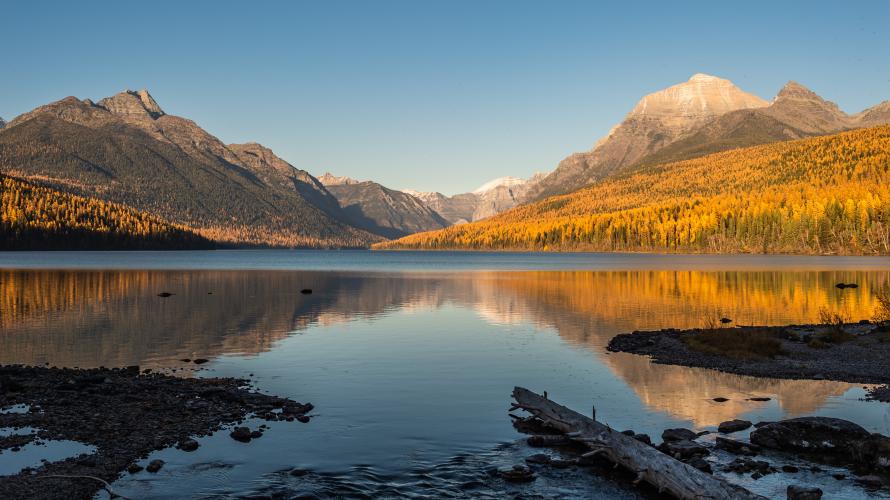
Fall’s Finale
~by Doug Stevens
Sometime in October, starting about the third week, it may seem like the color explosion of Fall is over. The leaves of the high country flora, that earlier showed off their flaming reds, oranges and yellows, wither, turn brown and drop, usually beneath an early snow. Lower down, the dazzling display of the of shimmering golds from the aspens and cottonwoods has passed, and they now stand barren with their leaves blanketing the ground around them, decomposing into new soil. The symphony of bugling elk is now a memory, days are becoming noticeably shorter than the nights, and not usually as warm and sunny. One starts to become resigned to the end of Indian Summer and the impending approach of the black and white of winter.
But wait! If you live on the west side of the state, this play is not yet over - there is one more brilliant extravaganza just around the corner – one final blaze of glory after all the other Fall colors have come and gone. For me, this is the crescendo of the whole color progression through September and October – its Fall’s last hurrah. If you live on the east side, or are new to the state and haven’t seen this before, it really is something to behold for the first time. I am, of course, talking about the color change of the western larch, often referred to as the “tamarack”.
The larch is a deciduous conifer. We are accustomed to thinking of all conifers as “evergreens”, but this genus does actually shed its needles every year. It is somewhat of a surprise to people who have moved to western Montana from areas of the country that do not have larches. It was to me when I moved west of the Continental Divide over 30 years ago.
To be specific, there are a few different species of Larix (larch) and they can be found through northern Canada down to New England, northern Europe, mountainous China and Japan, as well as the western US and Canada, west of the Divide. If you Google “tamarack”, however, you find out that the true tamarack is the eastern species – Larix laricina, and what we have out west is not tamarack per se, but the western larch, Larix occidentalis. However, I haven’t met too many people in Montana or Idaho who do not refer to our noble version of this tree as “tamarack”. It brings to mind that famous quote of Shakespeare’s Romeo and Juliet: “a rose by any other name would smell just as sweet”. Regardless of what common name you give it, and which region you find it, the Larix species can put on quite a show in late October.
Larches are very cold hardy and tolerant of many different environmental and climate conditions. This makes them “early populators”, meaning they have a competitive advantage to re-tree areas of the forest that have been opened up by fire, logging or other processes. The net effect of this is they can appear in big blocks, almost as a monoculture on some mountainsides. During the summer, when their needles are green, you may not notice this, however, when late October rolls around, literally whole mountainsides can turn a vibrant yellow with the changing color of their needles. Set against the deep blue of a sunny October day, it is truly one of the iconic images of western Montana.
A prime example of this can be seen from the North Fork of the Flathead River. To the east lies the western portion of Glacier National Park. Large unbroken swathes turn bright yellow every late October. Where earlier the scene was all green, it is now a solid yellow, especially the areas in the southern portion which are re-foresting from the devastating fires of the last 20 years.
This makes some of the drive-in destinations on the west side of Glacier a little further north still quite popular, even after the end of normal camping season, but nothing compared to the summer use. For example, Kintla Lake and Bowman Lake campgrounds stay open through October, and both are loaded with tamaracks. If you are a hiker, there are several great day hikes in this area, such as Numa Ridge and Numa Lookout, Akokala Lake. The Bowman Lake to Upper and Lower Quartz Lakes trail, a 13 mile loop, also makes for a wonderful day hike if you are staying at Bowman Lake. Area backpacking campsites remain open as well, such as the various Kintla and Bowman Lakes backcountry sites, as well as Upper and Lower Quartz Lakes and Logging Lake. These can be a bit “buggy” during the summer months, but at this time of year all those insects are long gone, as are the summer crowds. It is a great opportunity for the adventurer to indulge in this beautiful time of year up close and usually in solitude.
If you haven’t had the bounty of exploring the west side of Glacier, or ventured into some of the neighboring National Forest areas at this time of year, definitely put it on your calendar for next year. You won’t regret experiencing western Montana’s “Fall Finale”!
